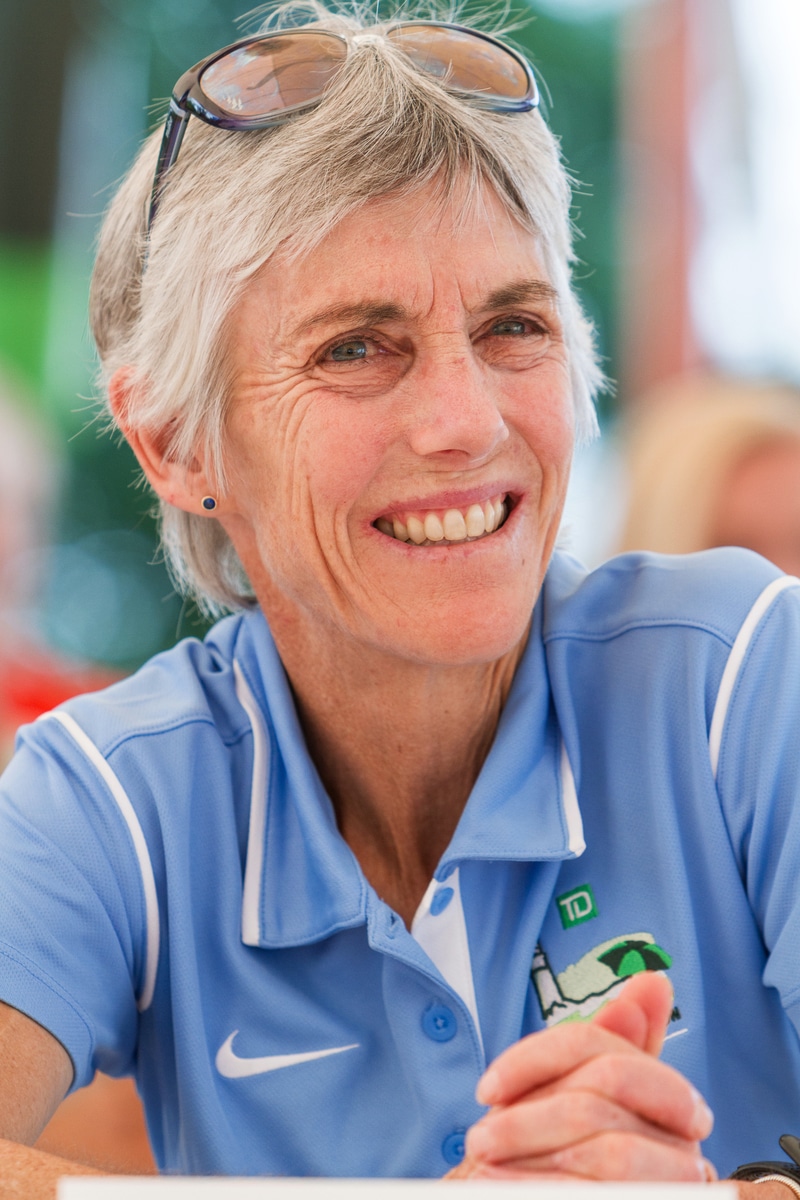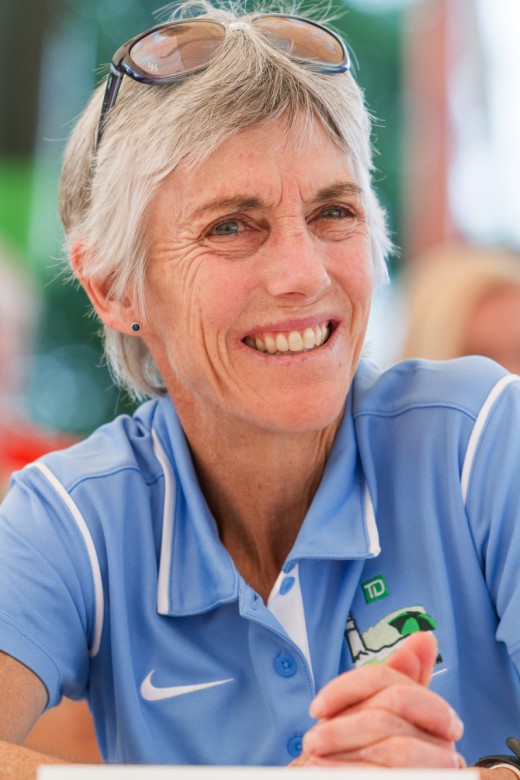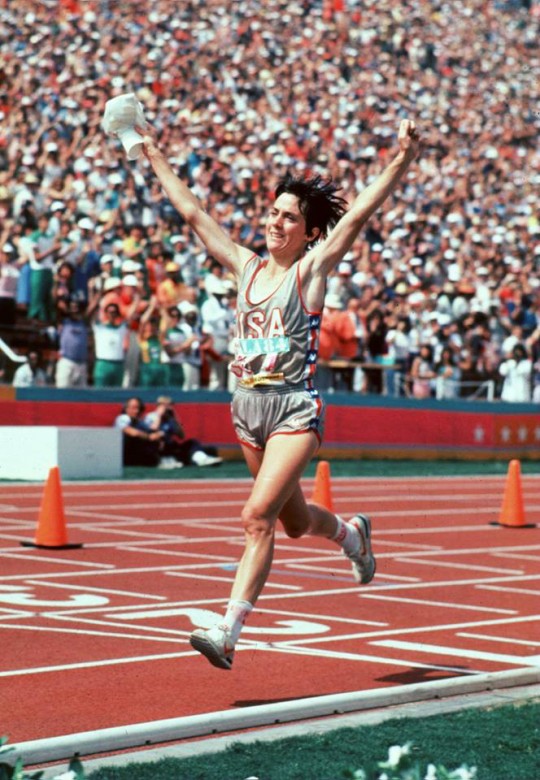Runner’s World | Joan Benoit Samuelson
Runner and Olympian, Joan Benoit Samuelson, on pioneering women’s running, winning the gold in ’84, and her plans to run a sub-3-hour marathon at the age of 60.

Joan Benoit Samuelson at an event for her TD Beach to Beacon 10K in her hometown of Cape Elizabeth, Maine.
Photo Credit : Courtesy of Joan Benoit Samuelson
Photo Credit : Courtesy of Joan Benoit Samuelson
Joan Benoit Samuelson won the first Women’s Olympic Marathon in 1984. Since that moment when the petite 27-year-old Maine native, wearing a big white hat, burst onto the track in Los Angeles, she’s been a mainstay icon in the running world. But talking to Samuelson you’d never guess this woman once set an American record, running the Chicago Marathon in 2:21:21, or that the soft-spoken athlete won the Boston Marathon twice. Samuelson is more apt to talk about her family, her garden, or the 10K race she founded and still runs in her hometown of Cape Elizabeth. At the age of 59, Samuelson is still a runner, churning out 50-70 miles a week, and still very much a part of the Olympic scene. In July, she was in Oregon for the trials, supporting the American team, and she plans to be in Rio for the 2016 Summer Games. We caught up with her shortly before she left for Brazil.
Your first Olympic win is now part of running history, but is there one specific memory that stands out to you from that day?
When I came through the tunnel in Los Angeles—as I was approaching the tunnel and got into the darkness of the tunnel I said, “Can you come out into the light and give back to a sport and a community that has given so much to you?” I decided within a couple seconds that I would, or I’d give it my best shot. That led to the founding of the TD Beach to Beacon 10k in Cape Elizabeth. We’ll be celebrating our 19th year on August 6th, which is the second day of the Olympics. What goes around comes around.
What type of runners does the TD Beach to Beacon 10k attract?
In the past we’ve had great representation from Africa, Japan, China, Europe, and Australia. So it’s certainly a global event in every sense of the word. At the same time, it’s a community event. Registration happens in stages. Apparently we filled up faster than any other race in the country this year. We give first priority to the residents of Cape Elizabeth because they really roll out the red carpet for us. When I founded the event I thought they’d either embrace it, or run us out of town. Fortunately they embraced it.
What is your involvement with the Olympics now?
I was out there for the first part of the trials in Oregon. I also went out in January this year and I was there to watch the men and women run the 10,000-meter races. I was cheering for [Mainer] Ben True and Molly Huddle [of Rhode Island]. There are a lot of other New England runners represented there, too. I was given the honor of awarding the medal to the women who made the 10,000-meter team. They keep me going. The younger runners are my inspiration for today. So that was a real honor to give a medal to Molly Huddle, Emily Infeld, and Marielle Hall. We have a great team going in the 10,000. I’m planning to go to Rio for two days for the Women’s Marathon and the two 10,000-meter races. I know Shalane Flanagan, Amy Cragg, and Des Linden quite well so I’ll be rooting for them. The African women will push them but I think we have some real medal contenders among those three.
Is the marathon your favorite distance?
I go through different phases where I really enjoy the marathon distance. I ran Boston a year ago. I wasn’t able to run it this year, which disappointed me because it was the 50th anniversary of women running Boston. My daughter ran and I was able to meet her at the finish line, but I had a back injury that kept me out.
Do you think running is something everyone can do?
I think everybody who is capable of moving forward on two feet is capable of running, or at least walking or walk-running or jogging. And the thing about our sport is that it’s enjoying huge growth. Races are filling up faster and faster and I think it’s because the sport is so accessible and affordable.
Running hasn’t always been accessible to women. What are some memories you have about your early running days in Maine?
I grew up in a neighborhood full of boys and I was the only girl in a family of four children. I have three older brothers—one of them gave me my first pair of running shoes. I think when someone close to you can appreciate your passion for a sport, that’s pretty special.
I was embarrassed to be seen running on the road. Ironically the only place I could run with reckless abandon was in Fort Williams, where at the time they didn’t allow any vehicular traffic, so nobody saw me. I’d walk there and run and then walk home. Then one day I saw a woman out running and it turned out to be the daughter of friends of my parents. I said, “If Lindsay can get out there and run, so can I.” And after that I just ran and ran and ran. And now the Beach to Beacon finishes in Fort Williams. So again, what goes around comes around.
You’ve trained in Maine your whole life. Do you run outside in the winter?
Yes. I can count the number of times I’ve run on a treadmill on two hands. I don’t care for the treadmill. Once I get going I warm right up. I don’t like looking at the thermometer before I go out the door. I can always peel a layer off and leave it on somebody’s mailbox and pick it up on the way back. I’ve never done any altitude training per say. I believe you can gain a lot more strength from adapting to different seasons then you can from going back and forth from different altitudes.
Do you still run every day?
Yes, I ran thirteen miles this morning. I have a couple of races coming up.
My last marathon was going to be the Olympic trials in Boston in 2008, where I tried to run a sub-2:50 at the age of 50. I accomplished that goal and thought that was the end. Then the following year I received a call from the head of the New York Road Runners wanting me to run in New York the following fall because it was the 40th anniversary of the New York City Marathon, which coincided with the 25th anniversary of my Olympic win. The press called and said, “We’d thought you’d be tired of marathons.” I said I was finished with competitive marathoning. But I never said what constitutes competitive marathons so I gave myself an out.
Do you have any pre-race rituals or superstitions?
Not really, not anymore. I used to have a few. I normally race in a white hat. Everyone wants to know what happened to the white hat during the Olympics. Well that hat got thrown away. I didn’t think anything of it and of course it’s the first question people ask me. The sun is an occupational hazard for me so I try to wear a hat when I run.

Photo Credit : Courtesy of Joan Benoit Samuelson
You’ve been noted for your “no frills” approach to nutrition. Can you talk a little about that?
I’m very holistic in my training. I eat what my body craves. We have a big garden at home. That’s my meditation time. I love to be out in the garden. I grow most of our food. I always plant my peas before Patriots’ Day and the Boston Marathon. We had peas before the fourth of July this year. I have kale, chard, lettuce, and all the greens coming in. The beans and tomatoes are blossoming. It’s a big garden. I feed the hungry. I feed the neighborhood. I’ve used very few nutritional supplements during my career.
How have you adjusted your training as you’ve aged?
I do more cross-training then I used to, which I think is a good thing. I’ve recently started yoga because I’ve been dealing with some flexibility issues. I do a lot of gardening at this time of year, I do some cycling, I do a lot of downhill and Nordic skiing in the winter; I really try to mix it up and I think that’s contributed to my longevity in the sport.
Did running change for you after becoming a mother?
Well, I refer to my career in two phases, BC and AD—before children and after diapers. Once I became a mother I planned my running around my day. So I went from planning my day around the running, to the running around the day. And now that the kids are grown and out of the house I have more flexibility than I did when they were home. But it’s all worked out. You just make it work if you’re passionate about whatever it is you’re pursuing.
Both of your two children are runners. Did you hope they’d pursue the sport?
We never forced them into it. As a matter of fact we tried to develop interests in other areas aside from athletics, like the arts and the environment. They’re well-rounded kids who are comfortable around people of all ages—they have a real joie de vivre and a passion for life. It’s been great but they came to running through other athletic interests. In 2014 I ran Boston with our two children, and I thought it would be great to try to run within 30 minutes of each other. My son ran a 2:50, I ran a 2:52, and my daughter ran a 3:14.
You’ve always made the balance between your home life and being a competitive athlete look easy. How do you account for this?
I think my parents instilled a real value in living as balanced a life as possible. In athletics we talk about mind, body, and spirit. I’ve just tried to balance those three components of my life. So running is not the only part of my life; I’m multifaceted, or I should say I have multiple interests. Even though I don’t have a job description, per say, I have very few idle moments. Every day is different and I never get bored.
Have you ever struggled with the solitary aspect of distance running?
I prioritize my day and week around running. Running is a really creative time for me. It’s when I do my best thinking. I do run with people occasionally, maybe once or twice a week. But I really enjoy that down time. Every run is enjoyable at some level. I run most every day. It’s who I am. It’s part of my constitution. I used to tell people it was my cup of coffee but since I turned 50 I’ve discovered coffee.
Did you not drink coffee before?
No, and the two go hand in hand. It gives me a little bit of a jolt. It really helps me get out the door in the morning as I age.
You make it look so easy. How?
I’ve had disappointing results, but no marathon is easy. I think when I really learned what the wall was all about was when I tried to run three marathons in one year and it really haunted me. It’s the emotional and mental piece as much as the physical piece. I don’t think I could work a 9-5 day sitting at a desk, so it’s all relative. I’d get really antsy.
You’ve given back so much to the running community, like you vowed to do all those years ago. Do you have any additional projects planned?
I have a vision of starting an East Coast endurance training camp for running, cycling, triathlons, and paddle sports. The athletes would eat food that’s grown where they’re training. During the off-peak training months we’d invite populations of people dealing with diabetes, cardiac issues, and cancer. They’d have access to the same foods to improve their health.
In terms of running, what should we expect to see from you next?
I do have one last goal in the sport of marathoning, and that’s to run a sub-3-hour marathon after I turn 60, which will happen next year. So that’s what keeps me going. For me it’s all about storytelling. I try to come up with a story I can tell through my running and that’s what motivates me.
Kelsey Liebenson-Morse
Kelsey Liebenson-Morse was born in Wisconsin, and spent part of her childhood in Florida, but considers New England home. Kelsey prefers to be outside and still re-reads the Harry Potter Series occasionally. She can often be spotted riding her bike or running. She believes herself to be the only ‘Kelsey Ananda Liebenson-Morse’ in the world, but has no way to prove it.
More by Kelsey Liebenson-Morse

